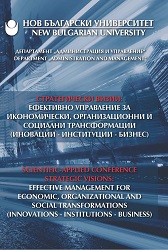
We kindly inform you that, as long as the subject affiliation of our 300.000+ articles is in progress, you might get unsufficient or no results on your third level or second level search. In this case, please broaden your search criteria.








This magazine is the English version of selected articles published in the pages of the review Paměť a dějiny (Memory and History), which is issued by the Institute for the Study of Totalitarian Regimes. It is almost two years since I last wrote an introduction to these articles. At that time my words had an obvious theme: 25 years had elapsed since the collapse of the Iron Curtain and the Communist regimes in Central and Eastern Europe. It was an opportunity to reflect on where we had got to from that fateful moment and what we actually know now about a recent past that continues to influence us greatly to this day.
More...
You have just opened the third edition of the English-language magazine Behind the Iron Curtain. It is comprised of articles published in the last three years (2012–2014) in the journal Paměť a dějiny (Memory and History), which is issued by the Institute for the Study of Totalitarian Regimes. I write this introduction just as the Czech Republic and other former Soviet Bloc states are marking the 25th anniversary of the fall of the Iron Curtain and systems based on the hegemony of communist or socialist parties. It is an occasion to assess how far we have come from that fateful moment and how much we know about the path taken by society in the Czech Republic and elsewhere in the 20th century (particularly in the period of totalitarian repression), how it changed society, and what insights can be gleaned from it today.
More...
One of the important functions of the Institute for the Study of Totalitarian Regimes is international cooperation. For us, this represents not only a source of information for concrete research and documentation projects and support for individual specialist growth, but it is also an irreplaceable system corrective of all of our work. Responsible and purposeful work in all the areas we have been charged with by law, support for democratisation processes, the systematic exchange of experience in the field of anti-totalitarian prevention – that is our mission, both in our own Central and Eastern European region and in the context of the European Union and beyond, particularly within the framework of boosting Euro-Atlantic ties and, for instance, bilateral relations with Israel.
More...
One of the most important tasks of the Institute for the Study of Totalitarian Regimes is the presentation of our research findings on an international level. With the passing in the Czech Republic of Act No. 181/2007 Coll. and the creation of the Institute and Security Services Archive, our country finds itself in a unique situation providing for the comparatively rapid attainment of a similar level of social discourse as in other post Communist countries which established parallel institutions in recent years.
More...


U Kraljevoj Sutjesci, stolnom mjestu bosanskih kraljeva i višestoljetnom staništu franjevaca, priređen je 17. i 18. listopada 2008. godine znanstveni skup “Stoljeća Kraljeve Sutjeske”. Vanjski povod bila je stota obljetnica izgradnje samostanske i župne crkve po projektu arhitekta Josipa Vancaša (1908). Ta se okolnost pokazala pogodnom prilikom za inventuru višestoljetne povijesti katolika i franjevaca sutješkoga kraja, počevši od vremena bosanske samostalnosti, preko višestoljetne vladavine Osmanlija, austro-ugarskog razdoblja – sve do najnovijeg vremena.
More...
Franjevačka teologija je u povodu stotinu godina svoga postojanja i djelovanja u Sarajevu (1909-2009) organizirala znanstveni skup i proslavu pod naslovom 100 godina Franjevačke teologije u Sarajevu: 1909.-2009. Znanstveni skup je održan 6. i 7. studenog 2009. u amfiteatru Franjevačke teologije, a 8. studenog – na dan blaženog Ivana Duns Škota, zaštitnika naše Teologije – održana je proslava tako što je svećeničkom euharistijskom slavlju predsjedao provincijal Bosne Srebrene fra Lovro Gavran. Za vrijeme euharistijskog slavlja izvedena je Missa Bosniensis Andrije Pavliča: Bosanska misa posvećena sv. Franji Asiškom, svim nesretnima, ispaćenima i izgubljenima ovoga svijeta, te bosanskim franjevcima i zboru Pontanima, koji je izveo misu. Zbor Pontanima je osnovao profesor naše Teologije fra Ivo Marković. Dirigirao je skladatelj Bosanske mise Andrija Pavlič (inače je dirigent zbora Pontanima Josip Katavić). Sudjelovali su Amila Bakšić, sopran; Zana Staniškovska, alt; Jasmin Bašić, tenor; Ivica Šarić, bas; i Dario Vučić, orgulje. Pokrovitelj Znanstvenog skupa i proslave je bio Željko Komšić, predsjedavajući Predsjedništva BiH.
More...
Après avoir reconfirmé la datation de Camille Enlart (vers 1421 ou 1421-1424) et identifié le comman-ditaire (l’évêque de Limassol Barthélemy Gui) dans une inscription fragmentaire, la présente étude explore: d’une part, les modèles des inscriptions en langue vernaculaire française de Pyrga (Chypre); d’autre part, la lo-gique du programme iconographique et le contexte culturel que sous-tend cette dernière. Dans la première par-tie, l’analyse des inscriptions de la chapelle prouve que le concepteur du décor peint a suivi un modèle manuscrit, sans doute un psautier avec un grand cycle d’enluminures. L’étude évoque trois termes de comparaison célè-bres: le Psautier de la reine Ingeburge (Chantilly, Bibliothèque du Musée Condé, 9 – tournant du xiiie siècle), le psautier de l’évêque Henri de Blois (Londres, British Library, Cotton Nero C iv – vers 1160) et le livre d’images de Marie de Rethel (Paris, Bibliothèque nationale de France, n. acq. fr. 16251 – vers 1285). Dans la source manuscrite reconstituée, les inscriptions en ancien français étaient probablement transcrites en tant que tituli, d’après une typologie tripartite: noms de fêtes religieuses, groupes nominaux ayant une fonction analogue et légendes sous forme d’énoncés introduits par l’adverbe coument. La langue des inscriptions de Pyrga, un français d’Outremer, présente les traits particuliers des scriptae chypriotes de la fin du Moyen Âge. De plus, on constate que la déco-ration de la chapelle inscrit le monument de Pyrga dans la catégorie des chapelles royales de l’Europe occidentale (xive et xve siècles). Le transfert du codex à la paroi concerne non seulement les images, mais également les textes qui accompagnent ces dernières. L’auteur s’intéresse ensuite à la disposition symétrique de la décoration dans les deux travées de la chapelle, ainsi qu’à la manière dont cette disposition accentue l’Uniatisme catholique-orthodoxe. La logique dos-à-dos de la décoration émule celle des icônes à double face – termes de comparaison directs pour la chapelle – notamment leur choix d’apparier deux scènes : la Crucifixion / la Mère de Dieu. Le con-cepteur du décor peint souhaitait évoquer l’osmose de deux églises: une église latine, orientée vers l’Est; la sug-gestion d’une église byzantine, orientée vers l’Ouest. Cela explique le choix particulier de la décoration des voûtes (christologique pour la travée Est et mariale pour la travée Ouest), la double représentation de l’An-nonciation (pour marquer l’orientation des deux églises) et le choix d’une composition de type pala d’altare pour la paroi Est, tandis que la paroi Ouest imite la décoration des templons byzantins. L’osmose des deux églises est indiquée de manière encore plus claire par le choix de représenter les martyriums des saints Étienne (signifiant l’Orient) et Laurent (signifiant l’Occident) au-dessus des entrées latérales. Ce serait une allusion à l’osmose des corps de ces saints dans la Coniunctio corporum sanctorum Stephani et Laurentii (bhl 4784b). Après une réévaluation du texte fragmentaire (aujourd’hui perdu) de l’inscription dédicatoire, il est évident que la dédicace proprement dite concernait l’Assomption de la Vierge. Qui plus est, l’osmose Est-Ouest était de nou-veau indiquée par la représentation dans un même cadre de la Dormition de la Mère de Dieu (sujet à connotation byzantine) et du Couronnement de la Vierge (thème occidental par excellence). Les textes littéraires des xive et xve siècles confirment la fixation chypriote de l’appariement de la Mère de Dieu avec la Passion du Christ, de même que plusieurs autres choix de la décoration de Pyrga. La signification de la décoration devait être multiple, en rapport avec la triple utilité du bâtiment: chapelle funéraire (pour Barthélemy Gui), chapelle royale (pour le couple Janus de Lusignan-Charlotte de Bourbon) et point d’entrée au monastère de Stavrovouni, qui hébergeait des reliques de la Sainte Croix.
More...


